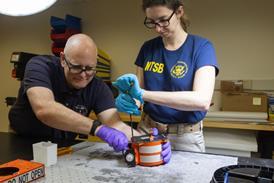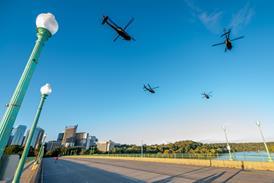Guy Norris/LOS ANGELES
Kelly Space & Technology (KST) has completed the first large-scale demonstration of its "Eclipse" tow-launch technique at Edwards AFB, California using a US Air Force-supplied Lockheed C-141A and QF-106A.
KST is developing a family of low-cost re-usable space launchers which will use the Eclipse technique to launch all missions. The C-141A tow aircraft represented a Boeing 747 which KST plans to use in service. The manned QF-106A was used to simulate one of a series of delta-winged launch vehicles being developed by KST to carry payloads to the edge of space.
The Astroliner is the largest vehicle planned and will be towed by the 747 to around 25,000ft (8,200m) where it will release the line and fire onboard rockets to boost it to around 400,000ft. Payload separation will take place between 400,000ft and 600,000ft after which an expendable second stage will ignite to deliver the payload or satellite to the desired orbit.
The Astroliner, which will be manned, will then re-enter the atmosphere before decelerating to subsonic speed. During the final phase of the descent the pilot will then start an onboard jet engine and fly the Astroliner like a conventional aircraft to a designated airfield.
The smaller vehicle, dubbed the Sprint, will follow a similar mission profile, but will be released from a higher altitude of 40,000ft and will climb under its own rocket power to altitudes of up to 740km (200nm) before releasing its payload to be boosted into orbit. KST is developing an add-on expendable second stage, which would be called the Express in this configuration.
The initial test "went well", says KST president Michael Kelly, despite the inadvertent release of the tow line at a much lower altitude (around 3,000ft) than planned, the demonstration providing acceptable handling conditions for the pilot of the QF-106A during take-off and initial climb, two of the team's biggest concerns.
Following further demonstrations this month and next, KST plans to begin building a sub-scale delta-winged version which "will be about the size of the F-106", says Kelly.
Source: Flight International























